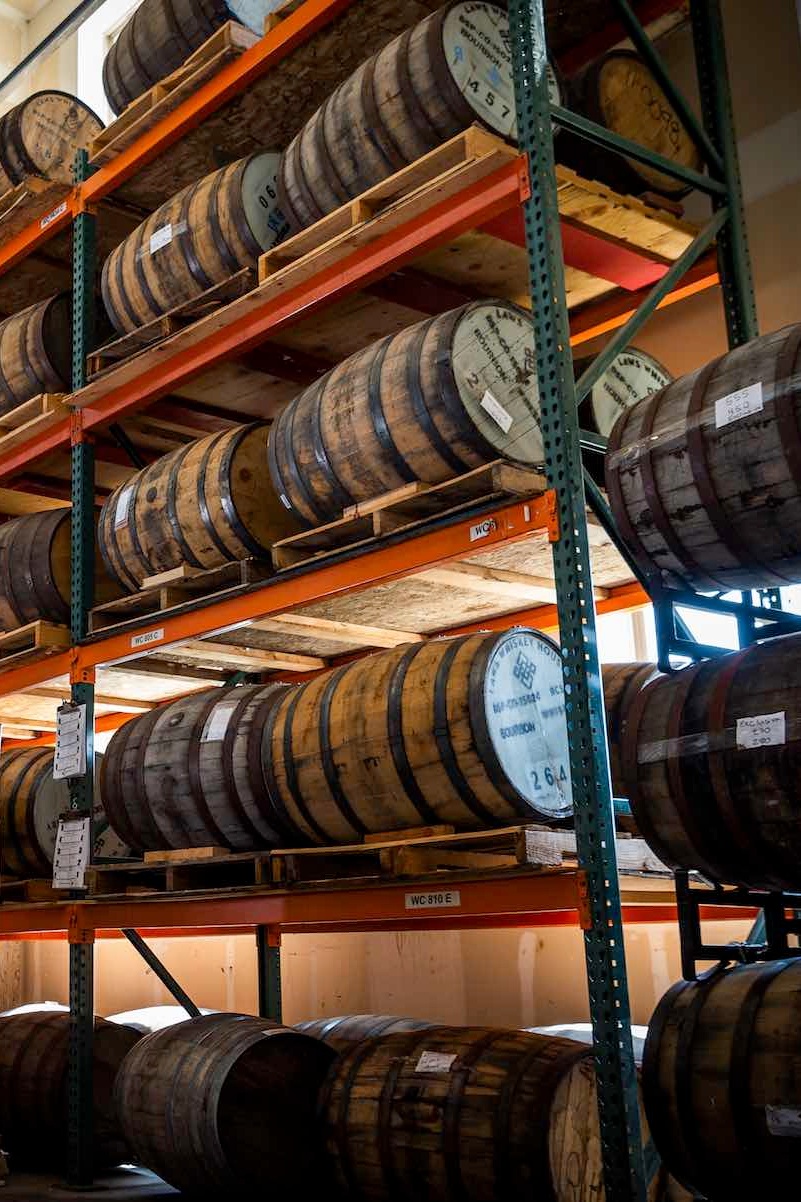The Magic and Mystery of Barrels
Many people don’t realize that all Montanya Rum starts out the same way—the un-aged rum that comes out of the stills can become any one of our rums. It’s the aging process that creates their distinctive flavor profiles. Montanya Rums age for anywhere from one to four years, and the barrels they’re stored in play a big role in the ultimate flavor and color profiles.
This Laws Whiskey House barrel ages Montanya Oro.
Co-founder and head distiller Brice Hoskin likes to say that barrels are magic. And there’s truth to that. Sure, science can explain a lot of what happens and it’s fascinating: rum moves in and out of the barrels’ pores, for example, and compounds like sucrose and vanillin get extracted from the wood and add specific notes of flavor to the rum.
Yet there’s still a sense of mystery to why distillers can take high proof, sharp-as-heck alcohol, put it in a wood barrel and have it come out smooth and flavorful. That mystery is one of the things Brice and co-founder Karen love about making rum, and about sharing that process with others. The best things in life always seem to be a combination of science and art.
We get a lot of questions about the barrels on tours and in the Tasting Room, so while we know our love of barrels borders on science nerd, we thought we’d share some of that info here:
The Life Cycle of a Barrel at Montanya Distillers
Montanya uses 53-gallon, charred, white oak barrels from Laws Whiskey that held whiskey anywhere from two to five years. When they show up at the bottling and distribution center two miles south of Crested Butte, they still have a tiny bit of whiskey sloshing around the bottom. That becomes part of the flavor when we fill the barrel with un-aged rum.
In any given barrel, we age our Oro rum first, for one year. (If we’re making Exclusiva, we’ll leave it in for two and a half years, and the limited-edition Aniversaria was aged in these barrels for three and a half years.) After removing the Oro, we refill the barrel and age Platino, also for one year. Each barrel can actually be used to age Platino twice, so a single barrel can produce three batches of rum. And once we’re finished with a Laws barrel, we sell it to beer makers.
We have two additional barrels in our lineup as well: a French Oak barrel that previously held Cabernet Sauvignon and Port (where we finish the Exclusiva and also aged the Aniversaria), and an American White Oak barrel that previously held Peach Street Bourbon (where we finished the Aniversaria).
The Science of the Barrels
Barrels or rum in the distribution center.
When rum or other spirits age in a barrel, the liquor moves in and out of the pores of the wood. That action imparts various flavors from the wood into the spirit. According to Brice, studies have shown that about 200 different chemical reactions happen between the barrels and the liquor, and the longer the spirit sits in the barrel, the more reactions can take place.
Distillers primarily use charred barrels because the charring breaks open the pores of the barrel and allows the rum or whiskey to move deeper into the wood. It also adds color faster. The level of char will vary, and distillers put spirits into barrels at different proofs based on the flavors they want out of the barrel.
Whiskey, for example, goes in at 110. Montanya Distillers rum goes in at 150. At 110, the spirit absorbs leathery and tobacco notes, and at 150, there are more notes like clove, vanilla, nutmeg, and cardamom.
The barrels that Montanya Distillers acquires from Laws Whiskey House are made by Cooperage. If you or someone you know has the last name of Cooper, it’s probable that someone in your or their lineage was a barrel maker.
We heart our dogs and our barrels at Montanya Distillers.
One other thing to note: the rum we put into the barrels is about 75% alcohol and 25% water. The alcohol dissolves some things in the wood and the water dissolves others. All of those become part of the rum’s flavor profile.
Our Platino and Oro rums are also the only single-barrel rums that we know of. Each bottle tells you the exact 53-gallon barrel that it came out of, making it traceable and slightly unique from other barrels. Every Oro is an Oro and Platino a Platino, but line up several bottles from different barrels, and an experienced palate will likely detect subtle differences.
(We’re not the only ones to note this. As Thijs Klaverstijn says in his article, Aging Spirits: The Magic of Oak, “there’s still an element of unpredictability to the whole science. Yes, maturation is part subtraction, part extraction, and part oxidation, but even two casks filled on the same day and stored next to each other will produce different results in the end.” Again, there’s that mystery.)
Related Content From the blog:
Grower Gene Adolph writes songs when he isn’t growing sugar cane. Get to know him.





